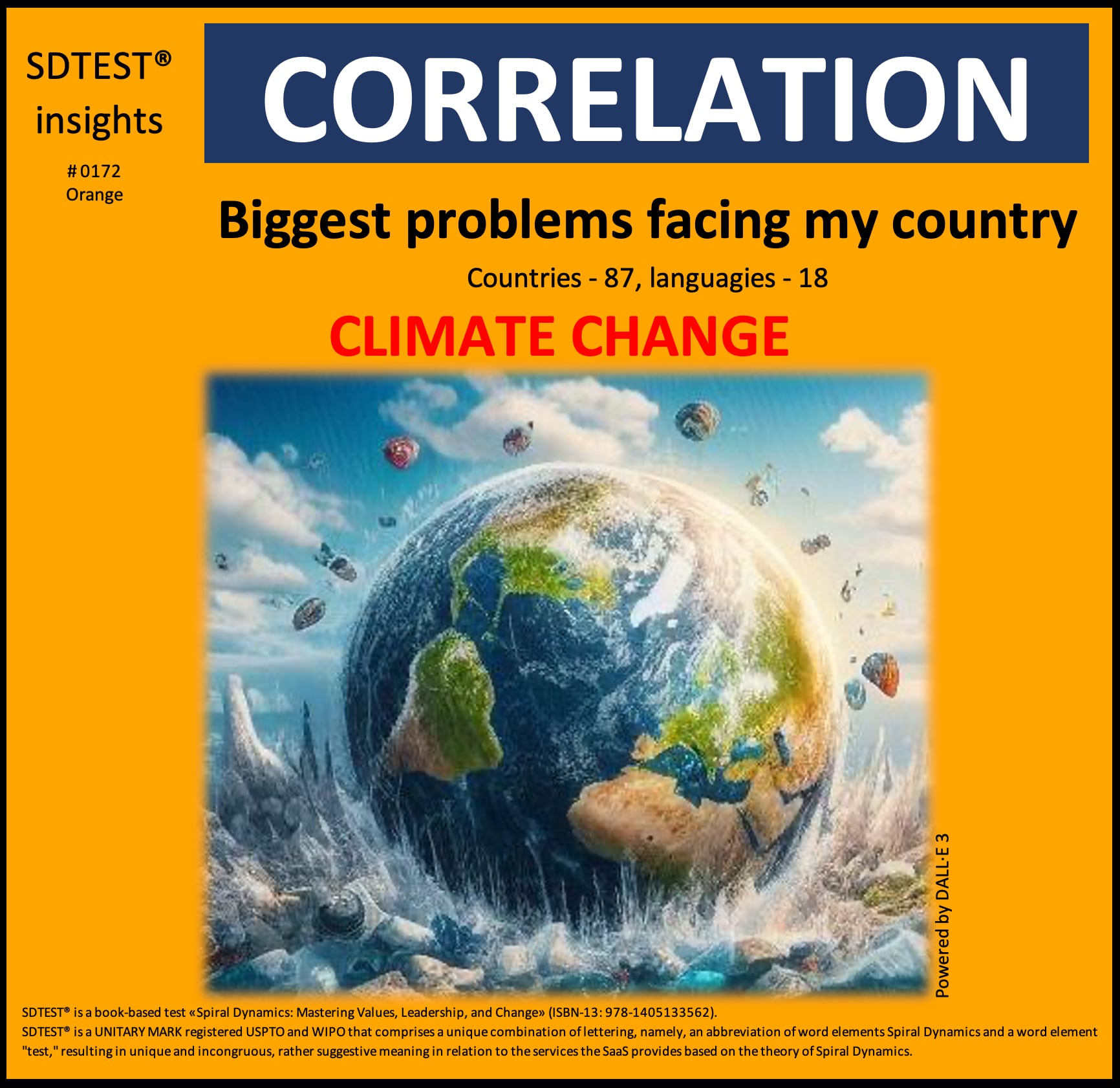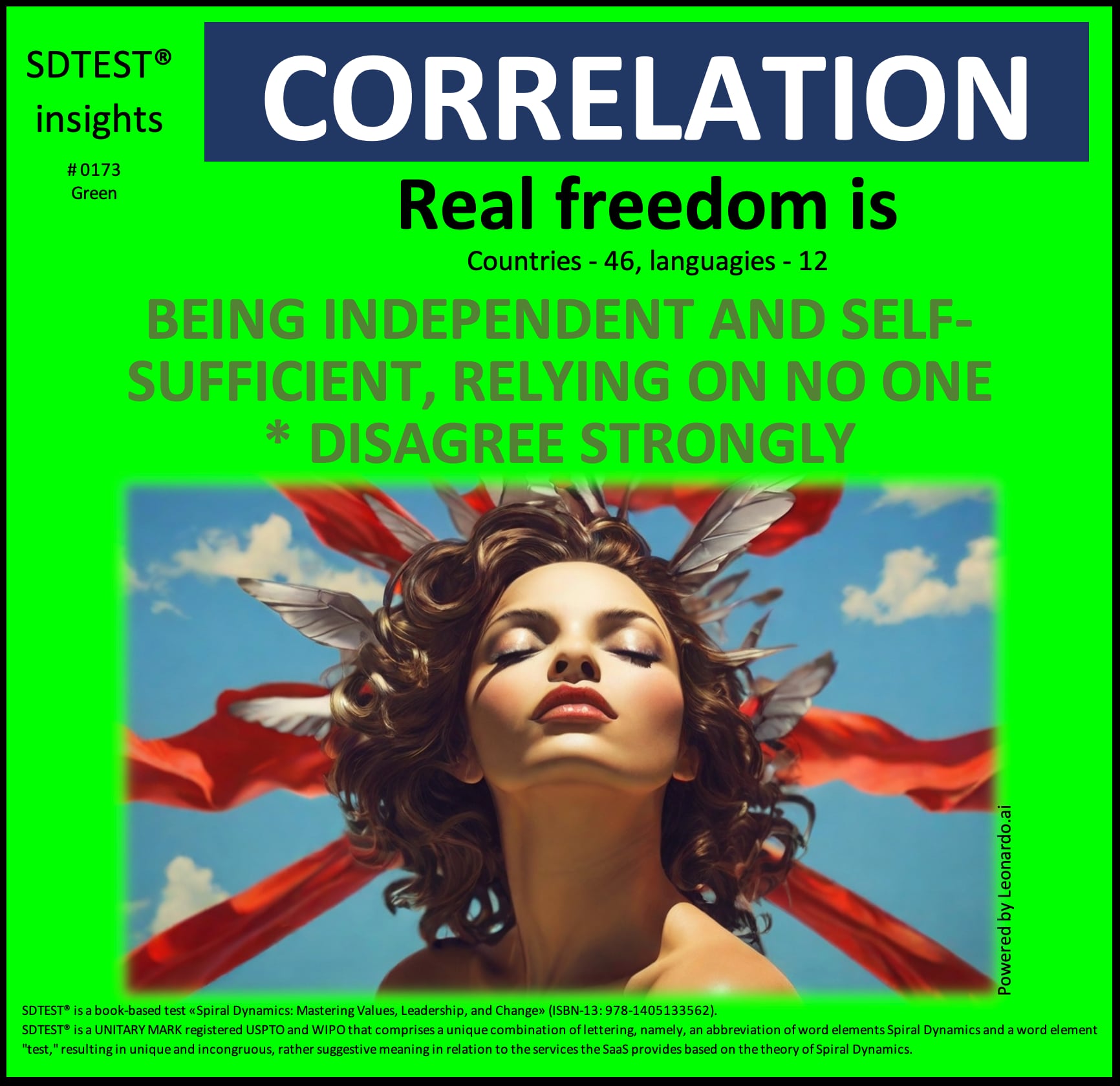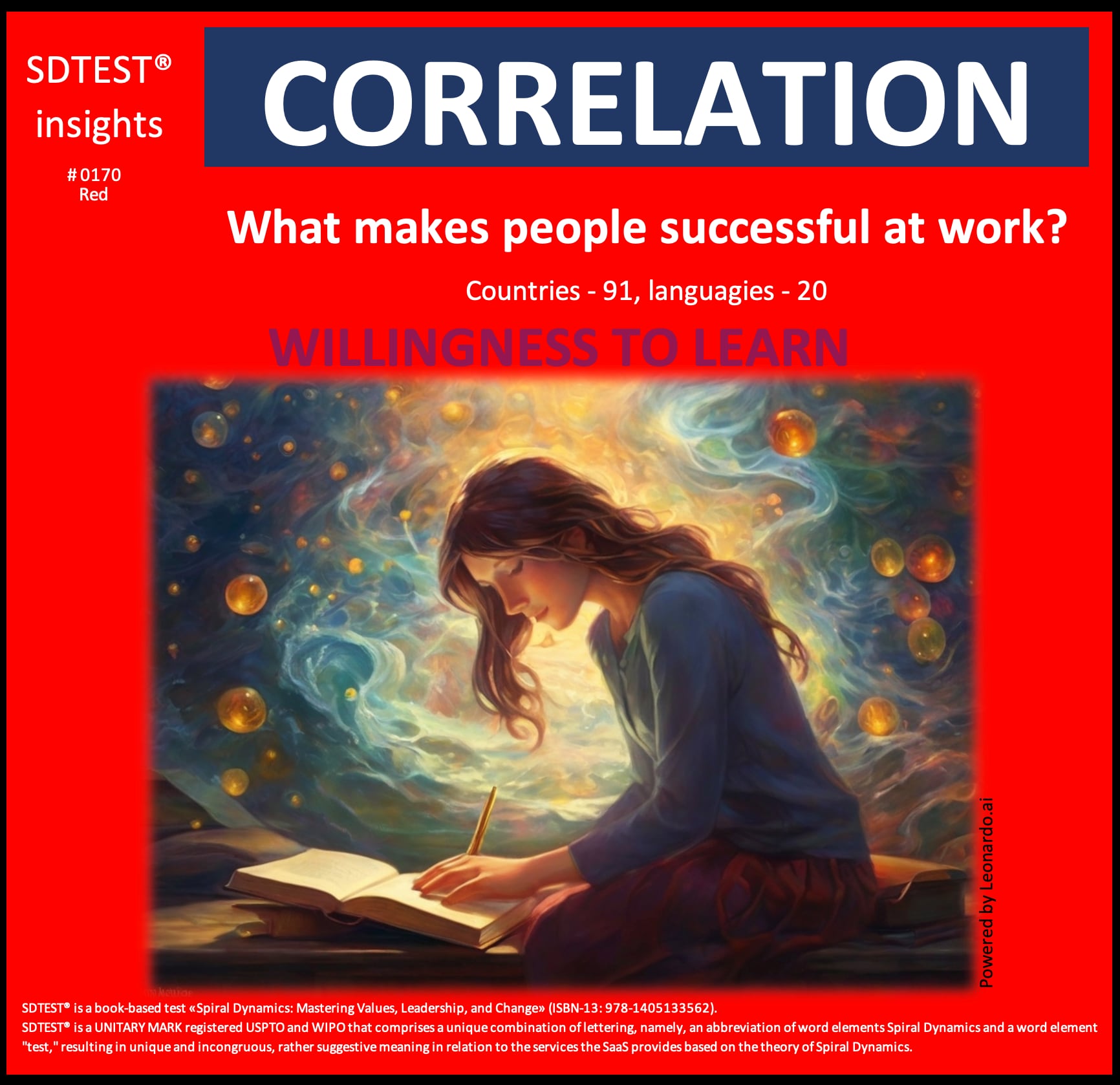This positive correlation of 0.2188 reflects different perspectives on the ability to stay positive and optimistic, which is a valuable skill and association with the Purple value system:
For organizations operating from the Purple wavelength, tradition, spirituality, and deference to authority are paramount. This positive correlation suggests that Purple-oriented companies may deeply value optimistic dispositions to reinforce faith in their operations' established mythologies, rituals, and belief systems. Pessimism could be seen as undermining the sanctioned orthodox narrative.
Teams resonating at the Purple level tend to emphasize reverence for lore, kinship bonding, and honoring mystical/supernatural forces. The positive correlation implies that such groups instinctively cultivate positive, hopeful mindsets to strengthen communal coherence, stave off threats to tradition, and maintain spiritual equilibrium. Skeptical attitudes risk severing the unifying mythos.
For those centered in the Purple vMeme, deriving meaning through connection to ancestral wisdom, rites of passage, and transcendent leadership is vital. This correlation suggests that Purple individuals may intrinsically equate optimism with the psychological fortitude required to embody sacred customs amidst the entropic tides of mundane existence. Pessimism represents a lapse in holy trust.
Ultimately, this positive correlation reveals optimism and unbridled hopefulness's foundational role in stabilizing the Purple altitude's core cosmological belief in an underlying harmonious order. In reality, imbued with invisible forces and mystical patterns, a positive orientation becomes both an ethical imperative and a psychological necessity for sustaining coherence.
This negative correlation of -0.0235 reflects different perspectives on the valuing willingness to learn and association with the Red value system:
Organizational Perspective:
Organizations dominated by Red values tend to prioritize power dynamics, unfettered self-expression, and immediate gratification over deferred learning. This negative correlation suggests that Red companies may view an eagerness to learn as a sign of weakness that undermines their posture of perpetual dominance. They likely prize audacity, risk-taking, and forcing circumstances to their will over patient knowledge acquisition.
Team Perspective:
Teams operating in a Red mindset often exhibit hyper-competitive, zero-sum dynamics with clearly delineated hierarchies. The negative correlation implies that such groups may perceive an expressed willingness to learn as destabilizing existing power structures. Learning represents vulnerability - an opening to be exploited by rivals jostling for position and control.
Individual Perspective:
Those centered in the Red frequency tend towards impulsive indulgence of desires, mistrust of constraints, and quests for autonomy through sheer force of individual will. This correlation suggests that for such people, overtly displaying a hunger to learn could be experienced as surrendering personal sovereignty to external authority. Willingness implies an inherent deficiency in challenging their defended self-images.
Ultimately, this negative correlation exposes a fundamental tension between Red's fixation on heroic self-determinism and the intrinsic humble posture learning requires. Acknowledging substantive knowledge deficits may unconsciously trigger Red's primal rejection of anything circumscribing its raw, expansive potency—a performative lust to learn risks admitting an intolerable inner void.
In our analysis of the poll "12 ways to build trust with others" (by Justin Wright [2]), we found an intriguing negative correlation that warrants closer examination:
-0.2301 between the Stay consistent in your actions (Being reliable builds confidence in you) / Disagree and the Blue stage.
The critical value of the correlation coefficient for a normal distribution, by William Sealy Gosset (Student) r = 0.2171. This negative correlation of -0.2301 meets the reliability criteria but does not necessarily imply causation.

Here we have two negations:
- negative correlation of -0.2301,
- Disagree with the statement Stay consistent in your actions (Being reliable builds confidence in you).
Together, they indicate agreement with the statement Stay consistent in your actions that equals the positive correlation between agreeing that consistency builds trust and association with Blue values:
This positive correlation reveals that within the Blue paradigm, there is a profound recognition that staying consistent in one's actions and being reliable is paramount for engendering trust and confidence.
Organizational Perspective:
Blue-oriented organizations likely see consistent adherence to defined processes, roles, and protocols as the bedrock of an orderly, trustworthy system. Companies at this level presumably have little tolerance for unreliable or erratic conduct that undermines the established way of operating.
Team Perspective:
For teams steeped in Blue values like following the chain of command and codes of conduct, individual consistency and dependability are crucial for fostering a cohesive, high-trust unit. Members who fail to execute their responsibilities per expectations reliably likely undermine the group's sense of order and confidence.
Individual Perspective:
At the individual level, those oriented toward the Blue frequency tend to derive self-worth from diligently upholding their duties to the collective. This correlation suggests that such people sincerely appreciate how staying consistent with commitments and embodying reliability are virtues that earn the trust and respect of hierarchical authorities.
This positive correlation highlights that for the Blue stratum, consistency, reliability, and predictable adherence to defined roles are sacrosanct ethical imperatives for maintaining trust and confidence in oneself, one's team, and the overarching system.
In our analysis of the poll "Biggest problems facing my country," we found an intriguing negative correlation that warrants closer examination:
-0.2414 between the Climate change and the Orange stage.
The critical value of the correlation coefficient for a normal distribution, by William Sealy Gosset (Student) r = 0.0503. This negative correlation of -0.2414 meets the reliability criteria but does not necessarily imply causation.

This negative correlation of -0.2414 reflects different perspectives on viewing climate change as a significant problem and its association with the Orange value system:
Organizational Perspective:
Companies operating from the quintessential Orange mindset tend to prioritize empiricism, calculated risk-taking, and an ethos of engineering continual technological progress. This negative correlation suggests such organizations may be more inclined to frame climate change through the lens of surmountable challenges to systematically solve via applied reason and scalable innovation rather than existential crises demanding restraint.
Team Perspective:
High-performing Orange teams exemplify the values of data-driven analysis, competitiveness, and optimizing for measurable results. The negative correlation implies that such groups may confidently view climate change's complexities as omnipresent design constraints to ingeniously circumvent through iterative breakthroughs ingeniously, fueling their ambitious solution-finding orientations.
Individual Perspective:
Those firmly anchored in the archetypal Orange individual stance tend to exhibit a self-directed mastery mindset, with desires for autonomy and an unwavering belief in human ingenuity's ability to overcome limitations. This correlation suggests such people may instinctively reframe climate change's threats as powerful catalysts for harnessing cold logic and bold experimentation to bend natural systems to their wills.
Ultimately, this negative correlation underscores the quintessential Orange conviction that systematic empiricism can unearth innovative pathways to transcend existential bottlenecks when leveraged by unflinching rationality. Daunting environmental ruptures awaken Orange's strengths - objectifying challenges into systematically manageable "problems" optimally addressed through applied cognition and iterative technological development.
In our analysis of the poll "Real Freedom Is," we found an intriguing positive correlation that warrants closer examination:
0.2155 between the Real freedom is being independent and self-sufficient, relying on no one / Disagree strongly and the Green stage.
The critical value of the correlation coefficient for a normal distribution, by William Sealy Gosset (Student) r = 0.1374. This positive correlation of 0.2155 meets the reliability criteria but does not necessarily imply causation.

This positive correlation of 0.2155 reflects different perspectives on disagreeing that real freedom means total self-sufficiency and association with Green values:
Organizational Perspective:
Organizations embodying Green ideals emphasize holistic well-being, participatory decision-making, and stakeholder interdependence. This positive correlation suggests that Green companies appreciate how genuine autonomy arises from cultivating synergistic ecosystems, challenging the myth of the self-contained individual. They likely view collaboration and unity as pathways to collective empowerment.
Team Perspective:
Teams operate from the Green wavelength prize egalitarian dynamics, open dialogue, and group cohesion. The positive correlation implies such teams instinctively reject notions of freedom premised on radical individualism and separation. Instead, their synergistic praxis celebrates how liberating group affiliation through authentic vulnerability can be.
Individual Perspective:
Those oriented toward Green consciousness tend to find meaning through interpersonal bonding, flattened hierarchies, and transcending us-vs-them mentalities. This correlation suggests that Green individuals may equate real freedom with the profound letting go into integral relationships—rooting identities within expansive webs of loving interdependence rather than atomized self-reliance.
Ultimately, this positive correlation reveals that within the Green altitude, independence and self-sufficiency represent confining constructs tethered to anthropocentric delusions of separateness. In contrast, true freedom is experienced as the emancipating realization of one's Being as a fluidly interdependent node within universal currents of co-arising unity. Self-reliance dissolves into holistic reciprocity.
In our analysis of the poll "Oxford Happiness Survey," we found an intriguing negative correlation that warrants closer examination:
-0.1572 between the I don't think that the world is a good place / Strongly Disagree and the Yellow stage.
The critical value of the correlation coefficient for a normal distribution, by William Sealy Gosset (Student) r = 0.0561. This negative correlation of -0.1572 meets the reliability criteria but does not necessarily imply causation.

This negative correlation of -0.1572 suggests that those operating from the Yellow frequency tend to agree with the statement, "I don't think the world is a good place."
This case has two negations:
- negative correlation of -0.1572,
- Strongly Disagree with the statement, "I don't think that the world is a good place."
Together, they indicate agreement with the statement, "I don't think that the world is a good place."
Organizational Perspective:
Yellow-oriented organizations likely avoid painting reality in absolutist, black-or-white terms. This correlation implies they perceive limitations in simplistic narratives that the world is purely "good" or "bad." Their approach involves penetrating the nuances and interrelated complexities underlying surface-level valuations.
Team Perspective:
The ability to hold multiple contexts simultaneously is critical for high-performing Yellow teams. The positive correlation suggests such groups resist dogmatically endorsing or rejecting statements about the world's essential nature as universally "good." Their work involves analyzing dynamic, co-arising phenomena from enriching additive viewpoints.
Individual Perspective:
At the individual level, those tending toward the Yellow altitude tend to have capacities for meta-perspective beyond rigid identification with any singular stance. This correlation indicates such people likely avoid lapsing into entrenched, absolutist assertions about the world aligning with or opposing pre-conceived ideals of "goodness." Their stance involves bearing witness to the ceaselessly unfolding existence.
This correlation betrays Yellow's skepticism towards delimiting the vast, interdependent Kosmos through limited either/or valuations. Their essence involves transcending dualistic certitudes, as the world's primordial essence transcends all idealized descriptors. An open, unfolding uncertainty guides their inquiry.
In our analysis of the poll "Why do people procrastinate?" we found an intriguing negative correlation that warrants closer examination:
-0.1115 between the ADHD (Attention-Deficit/Hyperactivity Disorder): Difficulty in sustaining attention and staying organized, resulting in delayed task completion. / Not Applicable and the Turquoise stage.
The critical value of the correlation coefficient for a normal distribution, by William Sealy Gosset (Student) r = 0.0754. This negative correlation of -0.1115 meets the reliability criteria but does not necessarily imply causation.

This negative correlation of -0.1115 suggests that those operating from the Turquoise value system tend to view ADHD (Attention-Deficit/Hyperactivity Disorder) as applicable - recognizing the challenges of sustaining attention, staying organized, and completing tasks on time.
This case has two negations:
- negative correlation of -0.1115,
- Not Applicable to ADHD (Attention-Deficit/Hyperactivity Disorder).
Together, they indicate agreement with the statement " ADHD (Attention-Deficit/Hyperactivity Disorder): Difficulty in sustaining attention and staying organized, resulting in delayed task completion."
Organizational Perspective:
Organizations embodying Turquoise ideals perceive themselves as living systems interdependent with vast networks. This correlation implies they appreciate how neurodivergent conditions like ADHD shape unique cognitive styles and experiences within their ecology. They likely work to create inclusive environments attuned to diverse neurocognitive needs.
Team Perspective:
High-functioning Turquoise teams tend to display a symbiotic, emergent synergy transcending individuals. The positive correlation suggests they don't dismiss ADHD as irrelevant but are deeply attuned to how it textures each member's distinct phenomenological landscape, aiming to integrate all cognitive particularities into their cohered praxis.
Individual Perspective:
At the Turquoise frequency, identity transcends rigid subject-object dualisms. This correlation indicates an understanding that ADHD isn't merely an objectified "disorder" but an experiential facet of neurodivergent being to be honored and metabolized - not pathologized through neurotypical assumptions of "normalcy."
Ultimately, this negative correlation reveals Turquoise's recognition that cognitive conditions like ADHD arise from complex, reciprocal interplays between unique neurobiology and sociocultural contexts - not discrete deficits located solely within individuals. Their holistic purview appreciates the irreducible Co-implication of neurodivergence and interdependent systems.








